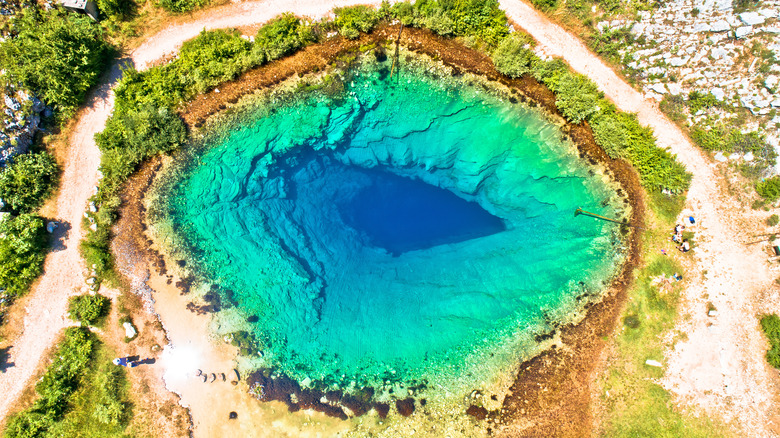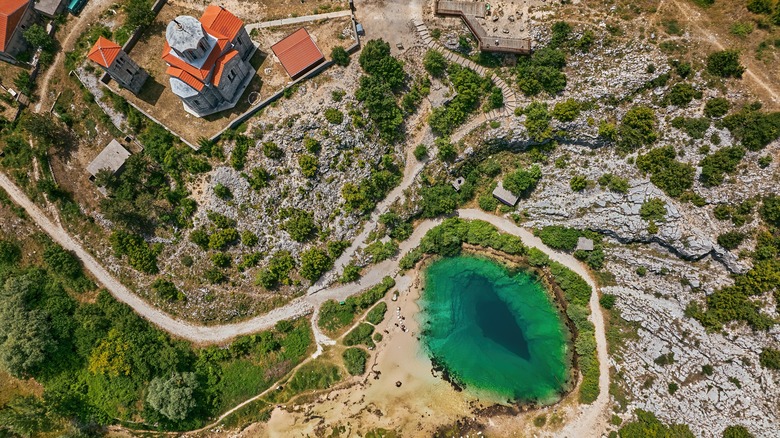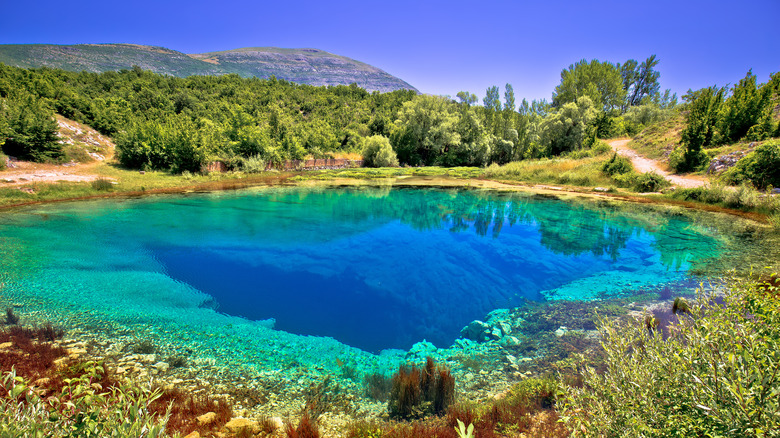Europe's Stunning Eye Of The Earth Seriously Belongs On Your Bucket List
Tucked away in the picturesque Dalmatian hinterland of Croatia, a hidden gem awaits those who seek the extraordinary. Officially called Izvor Cetine or the Cetina River Spring, it is commonly known as the Eye of the Earth. This natural wonder is a sight to behold, pun intended. Croatia, a country famed for its breathtaking coastline and historic cities, hides within its stunning interior a marvel yet to be on every traveler's radar — but it should be.
The Eye of the Earth is next to a 20th-century Serbian Orthodox church at the foothills of the Dinara Mountain Range, near the small 200-person Croatian village of Cetina. It is a karstic spring, similar to Yucatán's famous cenotes. These form when bedrock dissolves into a sinkhole, allowing groundwater to emerge from a deep cave, flowing up to the earth's surface. This spring is the source of the Cetina River, one of the most water-rich rivers in Croatia, which runs for 63 miles before emptying into the Adriatic Sea near Omiš.
Izvor Cetine has crystal clear water and a striking appearance resembling an eye when viewed from above. The sinkhole-like spring is almond-shaped, with shades of blue and green, surrounded by rocks in a near-perfect circle. The exact depth of the Eye of the Earth is still a subject of exploration; divers and the Croatian Institute of Nature reached lows of 500 feet. However, the exact depth is unknown and may be much more than that.
The experience at Izvor Cetine
Getting to Izvor Cetine is in itself an adventure. You'll need a car to make this trip; no public transport reaches this area. It's about an hour's drive from Šibenik, 45 minutes from Split, and between 3 and 4 hours from Dubrovnik. Visitors can enjoy a scenic drive through the Croatian countryside dotted with traditional villages and rolling hills. Once you arrive and park for free at the nearby church, the final part of the journey involves a short walk surrounded by nature's splendor.
Ultimately, the best thing to do at the Eye of the Earth is to admire the beauty and relax. Pack a picnic, sunscreen, a few towels, and just soak it all in. However, if you expect a warm swim, you will be disappointed — the water temperature hovers between 39 and 46 degrees Fahrenheit. But after sizzling in the Croatian sun, you may be compelled to take the icy plunge. Nature lovers can immerse themselves in the tranquility and serenity of the area.
Photographers will find themselves in a snapshot hotspot. The contrasting colors of the blue water, green vegetation, and rugged landscape provide a perfect canvas for capturing stunning photographs that will, no matter how much you try, look so good that they appear photoshopped. Make sure to visit on a sunny day so that the clarity and colors of the water are extra pronounced. One tip — if you have a drone, bring it (and thank us later).
Travel tips for your journey
The best time to visit the Eye of the Earth is during Croatia's shoulder season — spring and fall. It has taken the world (and social media) by storm, becoming quite famous among locals and international tourists. It's busiest between 10 a.m. and 4 p.m., especially during the high season. Early morning visits are optimal; aim for 8 a.m. or even earlier. You can join this small group tour with Dalmatia Untouched, which makes a stop here, among other points of interest in the region, such as Prozor Fortress and Belečki Bridge.
If you're looking for other things to do in the Izvor Cetine area, visit the nearby Dinara Nature Park. The park is named after Mount Dinara, the highest peak in Croatia, standing 6,007 feet above sea level. This peak, known as Sinjal, offers spectacular views of the surrounding area. Dinara Park offers various recreational activities such as hiking, mountaineering, bird watching, and exploring its many natural and cultural landmarks.
As Izvor Cetine gains popularity, a growing emphasis on sustainability emerges. The spring is a protected Hydrological Monument of Croatia, and visitors are encouraged to respect the environment. Visiting is free of charge, and there are no lifeguards, restaurants, or other attractions around it. The remote site is rural and pristine — best kept for conservation purposes. So, set your sights on the Eye of the Earth and add it to your bucket list; you won't regret it.


